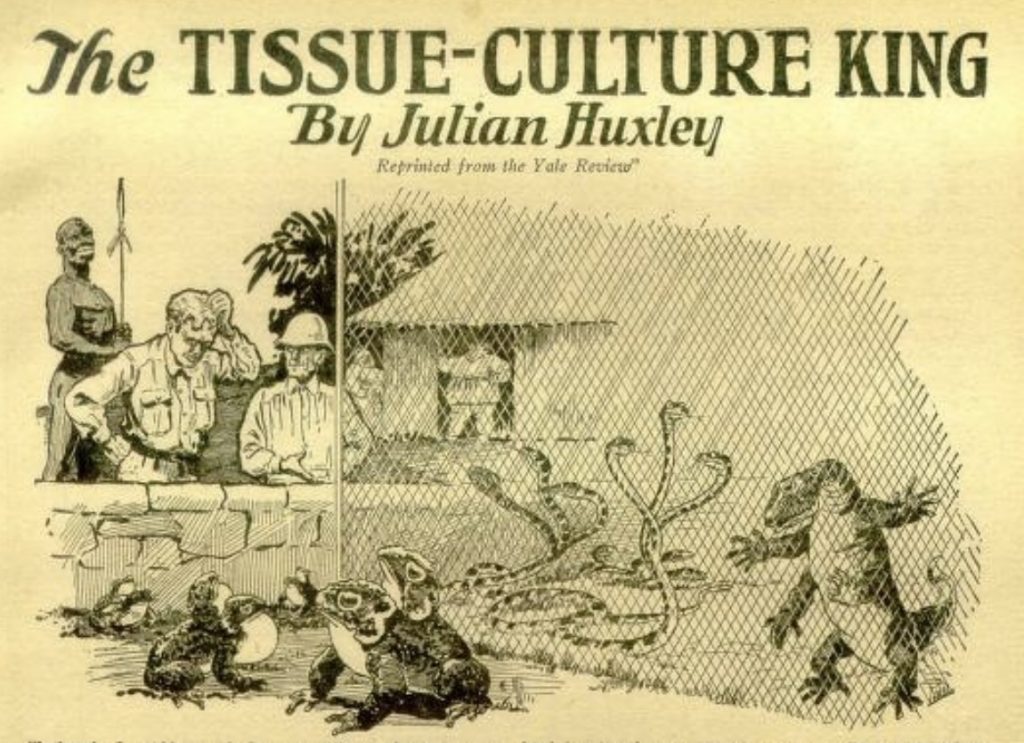THE TISSUE-CULTURE KING (3)
By:
September 18, 2022

HiLoBooks is pleased to serialize “The Tissue-Culture King,” a 1926 short story by biologist Julian Huxley, for HILOBROW’s readers. Sometimes subtitled “A Parable of Modern Science,” it is an allegory of science’s subordination to capitalist imperatives. Fun fact: Here is where you will find one of the earliest mentions of the anti-telepathic properties of tin-foil hats.
ALL INSTALLMENTS: 1 | 2 | 3 | 4 | 5 | 6 | 7 | 8 | 9.
Hascombe demonstrated his preparation with greater interest than he had ever done to first-year medical students in the old days. He explained that the blood was composed of little people of various sorts, each with their own lives, and that to spy upon them thus gave us new powers over them. The elders were more or less impressed. At any rate the sight of these thousands of corpuscles where they could see nothing before made them think, made them realize that the white man had power which might make him a desirable servant.
They would not ask to see their own blood for fear that the sight would put them into the power of those who saw it. But they had blood drawn from a slave. Hascombe asked too for a bird, and was able to create a certain interest by showing how different were the little people of its blood.
“Tell them,” he said to the interpreter, “that I have many other powers and magics which I will show them if they will give me time.”
The long and short of it was that he and his party were spared — He said he knew then what one felt when the magistrate said: “Remanded for a week.”
He had been attracted by one of the elder statesmen of the tribe — a tall, powerful-looking man of middle-age; and was agreeably surprised when this man came round next day to see him. Hascombe later nicknamed him the Prince-Bishop, for his combination of the qualities of the statesman and the ecclesiastic. His real name was Bugala. He was as anxious to discover more about Hascombe’s mysterious powers and resources as Hascombe was to learn what he could of the people into whose hands he had fallen, and they met almost every evening and talked far into the night.
Bugala’s inquiries were as little prompted as Hascombe’s by a purely academic curiosity. Impressed himself by the microscope, and still more by the effect which it had had on his colleagues, he was anxious to find out whether by utilizing the powers of the white man he could not secure his own advancement. At length, they struck a bargain. Bugala would see to it that no harm befell Hascombe. But Hascombe must put his resources and powers at the disposal of the Council; and Bugala would take good care to arrange matters so that he himself benefited. So far as Hascombe could make out, Bugala imagined a radical change in the national religion, a sort of reformation based on Hascombe’s conjuring tricks; and that he would emerge as the High Priest of this changed system.
Hascombe had a sense of humor, and it was tickled. It seemed pretty clear that they could not escape, at least for the present. That being so, why not take the opportunity of doing a little research work at state expense — an opportunity which he and his like were always clamoring for at home? His thoughts began to run away with him. He would find out all he could of the rites and superstitions of the tribe. He would, by the aid of his knowledge and his scientific skill, exalt the details of these rites, the expression of those superstitions, the whole physical side of their religiosity, on to a new level which should to them appear truly miraculous.
It would not be worth my troubling to tell all the negotiations, the false starts, the misunderstandings. In the end he secured what he wanted — a building which could be used as a laboratory; an unlimited supply of slaves for the lower and priests for the higher duties of laboratory assistants, and the promise that when his scientific stores were exhausted they would do their best to secure others from the coast — a promise which was scrupulously kept, so that he never went short for lack of what money could buy.
He next applied himself diligently to a study of their religion and found that it was built round various main motifs. Of these, the central one was the belief in the divinity and tremendous importance of the Priest-King. The second was a form of ancestor-worship. The third was an animal cult, in particular of the more grotesque species of the African fauna. The fourth was sex, con variazioni. Hascombe reflected on these facts. Tissue culture; experimental embryology; endocrine treatment; artificial parthenogenesis. He laughed and said to himself: “Well, at least I can try, and it ought to be amusing.”
RADIUM AGE PROTO-SF: “Radium Age” is Josh Glenn’s name for the nascent sf genre’s c. 1900–1935 era, a period which saw the discovery of radioactivity, i.e., the revelation that matter itself is constantly in movement — a fitting metaphor for the first decades of the 20th century, during which old scientific, religious, political, and social certainties were shattered. More info here.
SERIALIZED BY HILOBOOKS: James Parker’s Cocky the Fox | Annalee Newitz’s “The Great Oxygen Race” | Matthew Battles’s “Imago” | & many more original and reissued novels and stories.
